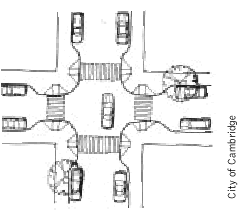4. Marked Crosswalks and Enhancements
 Marked
crosswalks indicate locations for pedestrians to cross and signify to
motorists to yield to them. Crosswalks are often installed at signalized
intersections and other selected locations. Various crosswalk marking
patterns are given in the MUTCD2.
Marked crosswalks are desirable at high pedestrian volume locations to
guide pedestrians along a preferred walking path. They can be raised or
installed in conjunction with other enhancements that physically reinforce
crosswalks and reduce vehicle speeds. It is also useful to supplement
crosswalk markings with warning signs. In some locations, signs can get
"lost" in visual clutter so care must be taken in placement.
The most effective approach combines engineering treatments with enforcement
and education.
Marked
crosswalks indicate locations for pedestrians to cross and signify to
motorists to yield to them. Crosswalks are often installed at signalized
intersections and other selected locations. Various crosswalk marking
patterns are given in the MUTCD2.
Marked crosswalks are desirable at high pedestrian volume locations to
guide pedestrians along a preferred walking path. They can be raised or
installed in conjunction with other enhancements that physically reinforce
crosswalks and reduce vehicle speeds. It is also useful to supplement
crosswalk markings with warning signs. In some locations, signs can get
"lost" in visual clutter so care must be taken in placement.
The most effective approach combines engineering treatments with enforcement
and education.
Pedestrians are sensitive to out-of-the-way travel, and reasonable accommodation should be made to make crossings both convenient and at safe locations with adequate visibility. Recommended guidelines for cross-walk installation at controlled locations are given in Appendix C (see the Library Section). These guidelines are based on a major study of 1000 marked crosswalks and 1000 unmarked crossings in 30 US cities3.
Crosswalk materials
It is important to ensure that crosswalks are visible to motorists, particularly at night. Crosswalks should not be slippery or create trip hazards. Even though brick, granite, or cobblestones are aesthetically appealing materials, they are generally not appropriate for crosswalks. The best material today for marking crosswalks is inlay tape which is installed with new or repaved streets. It is highly reflective, long lasting, slip-resistant and does not require maintenance. Although initially more costly, inlay tape is more cost-effective than paint or thermoplastic in the long run. Thermoplastic is also superior to paint, being longer lasting and more visible.

Overhead Illuminated Crosswalks
A novel overhead illuminated crosswalk sign and high-visibility ladder style crosswalk were evaluated in Clearwater, Florida. Using an experimental/control design, the effect of the novel treatments on driver and pedestrian behavior was determined. A significant 30 percent to 40 percent increase in daytime driver yielding behavior was found. A smaller (8 percent) and statistically insignificant increase in nighttime driver yielding behavior was observed. A large (35 percent) increase in crosswalk usage by pedestrians was noted along with no change in pedestrian overconfidence, running, or conflicts. It was concluded that the high-visibility crosswalk treatments had a positive effect on pedestrian and driver behavior on the relatively narrow low-speed crossings that were studied. Additional work is needed to determine if they will also have a desirable effect on wider, higher-speed roadways.
For a full text document, check the last item of the "Related Documents" portion of the Library section of this CDROM, entitled "An Evaluation of High Visibility Crosswalk Treatments."
Purpose:
- Warn motorists to expect pedestrians crossing
- Indicate preferred crossing locations
Considerations:
- Crosswalk locations should be convenient for pedestrian access.
- Crosswalk markings alone are unlikely to significantly affect pedestrian safety. Ideally, cross-walks should be done in conjunction with other measures such as curb extensions to improve the safety of a pedestrian crossing.
Estimated cost
$100 for a regular striped cross-walk, $300 for a ladder crosswalk and $3,000 for patterned concrete crosswalk.